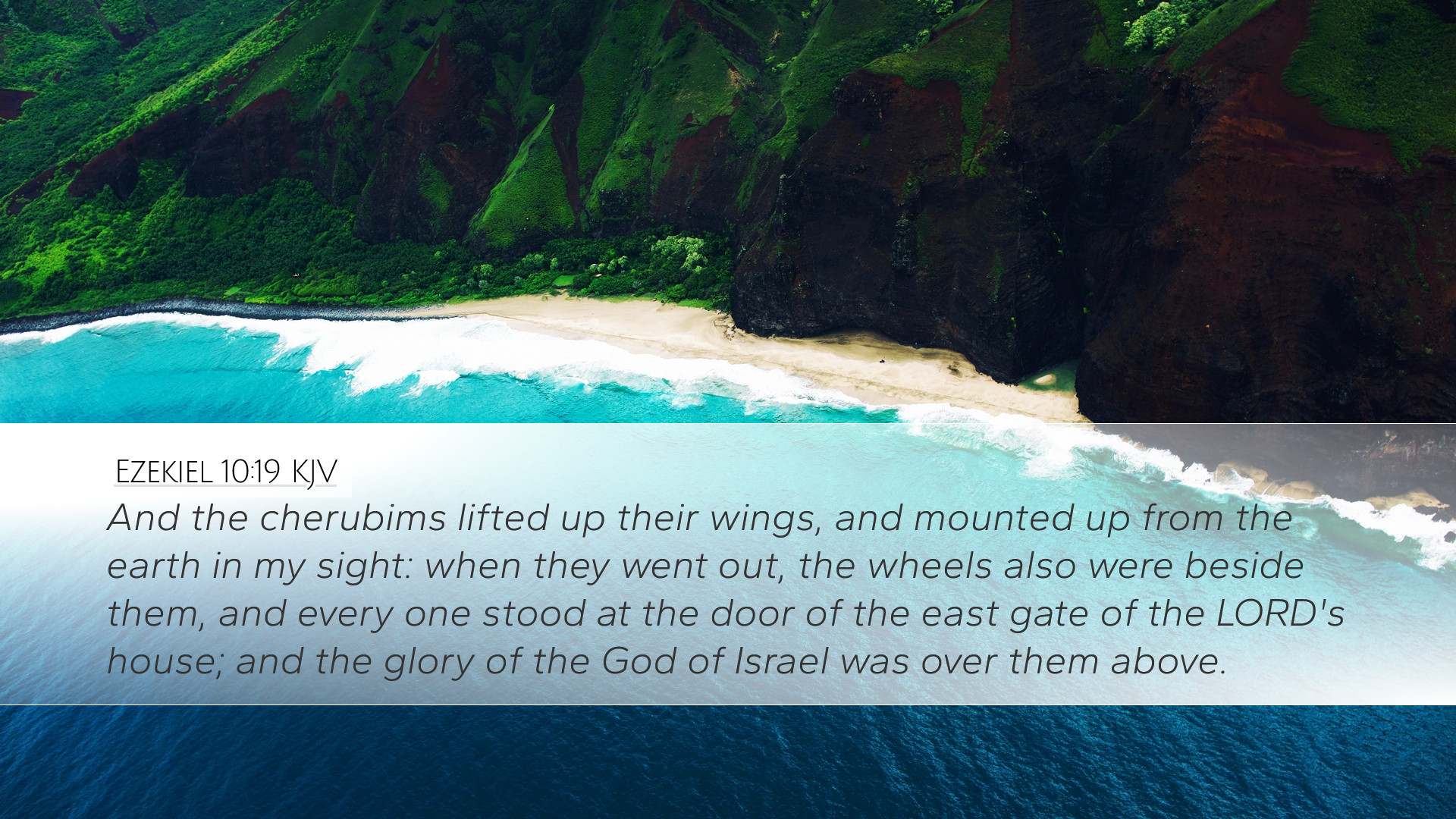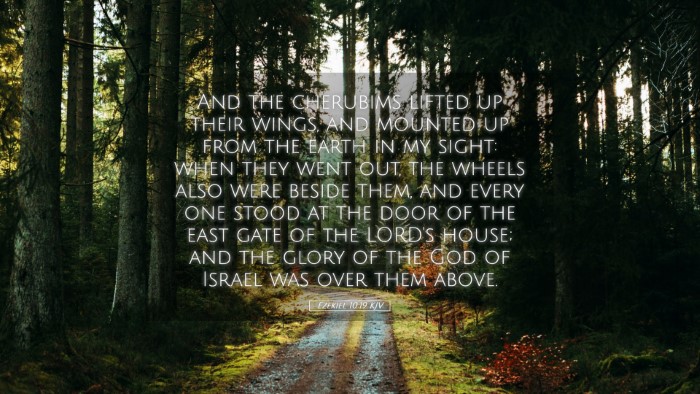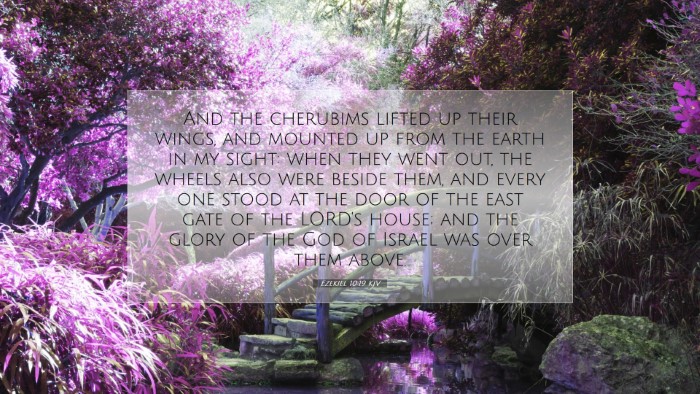Ezekiel 10:19 Commentary
Verse Text: "And the cherubim spread their wings, and mounted up from the earth in my sight: when they went out, the wheels also were beside them: and every one stood at the door of the east gate of the LORD's house; and the glory of the God of Israel was over them above."
This verse from Ezekiel marks a pivotal moment in the prophet's vision, where divine glory and the dynamic presence of God are manifested through the movement of the cherubim. The significance of Ezekiel 10:19 lies in its theological implications regarding God's presence, His judgment, and the relationship between heaven and earth.
Contextual Setting
The book of Ezekiel is rooted in the Babylonian exile, a period of immense distress for the people of Israel. Ezekiel, as a prophet, functions to relay God's messages concerning judgment and hope. In chapters 8 through 11, the prophet witnesses a series of visions that frame Israel's apostasy and the consequent departure of God's glory from the temple.
Summary of Themes
- The Glory of God: God's glory is a central theme in Ezekiel and is represented through the cherubim. The moving presence of these heavenly beings signifies both God's impending judgment and His ongoing presence.
- Divine Withdrawal: The imagery of the cherubim departing from the temple underscores God's withdrawal from His people, a tragic but necessary act due to their persistent sin and idolatry.
- Hope of Restoration: Despite the ominous portrayal of God's glory leaving, the vision ultimately points toward a future hope of restoration and the return of God's presence among His people.
Commentary Insights
Matthew Henry's Perspective
Matthew Henry emphasizes the visual elements of the cherubim’s movement, noting that their wings spread are indicative of a divine transference of power. He highlights the importance of the wheels, which signify the omnipresence of God and the continuous vigilance of divine support. His commentary also explores the relationship between the outward manifestation of God’s glory and the inner spiritual state of the people, suggesting that their sinful actions have led to this alarming vision of departure.
Albert Barnes' Insights
Albert Barnes elaborates on the notion that the cherubim represent a symbolic connection between God and man. He notes that their movement signifies both a judgment upon Israel for their idolatry and a pathway for future hope. Barneses’ reflections on the wheels indicate the idea that God's action is not confined to a singular location; rather, His reach extends beyond the temple, emphasizing the universality of His glory. Furthermore, he asserts that this passage conveys a critical lesson about God's nature - that He is not merely a distant deity but one whose presence guides and watches over His creation.
Adam Clarke's Analysis
Adam Clarke provides theological depth to the symbolism of cherubim and wheels, interpreting them as reflections of divine judgment and mercy. He posits that the ascension of the cherubim serves a dual purpose, representing both judgment upon Jerusalem for its sins and a promise of divine presence in exile. Clarke’s emphasis on the “door of the east gate” encapsulates the idea of a new direction for God’s people, indicating that while they face judgment, there remains a potential for redemption.
Theological Implications
The departure of the glory of God from the temple as described in Ezekiel 10:19 carries profound implications for theology:
- Holiness of God: This passage underscores the holiness of God and His intolerance for sin, calling believers to a higher standard of righteousness and devotion.
- The Nature of Divine Presence: It highlights that God’s presence is intimately connected to the moral and spiritual integrity of His people, reminding us that proximity to God is contingent upon faithful living.
- Hope in Judgment: Despite the somber tone of divine withdrawal, there remains an undercurrent of hope for reconciliation, suggesting that God's ultimate desire is restoration, not abandonment.
Practical Applications
For pastors, theologians, and Bible scholars, Ezekiel 10:19 serves as a powerful reminder of the following:
- Emphasis on Repentance: Just as the Israelites were called to turn from their iniquity, modern believers are also challenged to pursue repentance and establish a sincere relationship with God.
- Understanding Divine Guidance: The mobility of the cherubim and wheels can remind leaders of the dynamic nature of God's guidance, urging them to remain sensitive and responsive to His leading.
- Hope in Crisis: The promise of future restoration gives encouragement to those facing trials, reminding them of God's unwavering presence even in times of judgment or exile.
Conclusion
Ezekiel 10:19 encapsulates a critical transition in the relationship between God and His people. Through the imagery of the cherubim, the wheels, and the glory of God, this passage challenges believers to reflect on their walk with God, urging repentance and faithfulness while simultaneously offering hope in God's redemptive plan. The insights provided by Matthew Henry, Albert Barnes, and Adam Clarke enrich our understanding of this text, revealing a tapestry of divine judgment intertwined with grace that extends beyond the immediate context of exile, pointing towards the ultimate restoration of God’s presence with His people.


